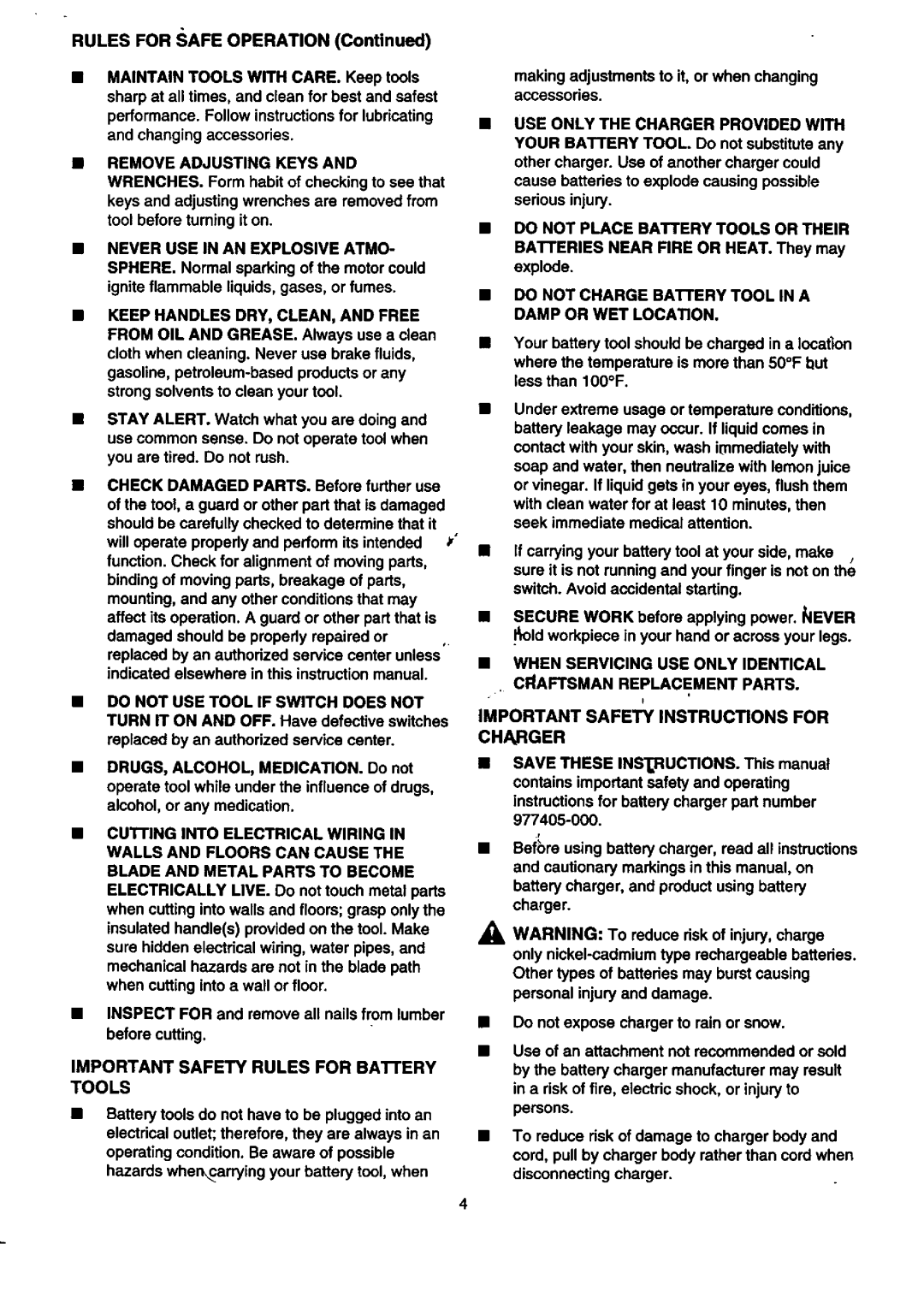
RULES FOR SAFE OPERATION (Continued)
•MAINTAIN TOOLS WITH CARE. Keep tools sharp at all times, and clean for best and safest performance. Follow instructions for lubricating and changing accessories.
•REMOVE ADJUSTING KEYS AND WRENCHES. Form habit of checking to see that keys and adjusting wrenches are removed from tool before tuming it on.
•NEVER USE IN AN EXPLOSIVE ATMO- SPHERE. Normal sparking of the motor could ignite flammable liquids, gases, or fumes.
KEEP HANDLES DRY, CLEAN, AND FREE FROM OIL AND GREASE. Always use a clean cloth when cleaning. Never use brake fluids, gasoline,
STAY ALERT. Watch what you are doing and use common sense. Do not operate tool when you are tired. Do not rush.
CHECK DAMAGED PARTS. Before further use
of the tool, a guard or other part that is damaged should be carefully checked to determine that it will operate propedy and perform its intended ,V function. Check for alignment of moving parts, binding of moving parts, breakage of parts, mounting, and any other conditions that may affect its operation. A guard or other part that is damaged should be propedy repaired or
t.
replaced by an authorized service center unless indicated elsewhere in this instruction manual.
•DO NOT USE TOOL IF SWITCH DOES NOT TURN IT ON AND OFF. Have defective switches replaced by an authorized service center.
•DRUGS, ALCOHOL, MEDICATION. Do not operate tool while under the influence of drugs, alcohol, or any medication.
•
•INSPECT FOR and remove all nails from lumber before cutting.
IMPORTANT SAFETY RULES FOR BA'I-FERY TOOLS
Battery tools do not have to be plugged into an electrical outlet; therefore, they are always in an operating condition. Be aware of possible hazards wher_arrying your battery tool, when
making adjustments to it, or when changing accessories.
USE ONLY THE CHARGER PROVIDED WITH YOUR BATTERY TOOL. Do not substitute any other charger. Use of another charger could cause batteries to explode causing possible serious injury.
•DO NOT PLACE BATTERY TOOLS OR THEIR BATTERIES NEAR FIRE OR HEAT. They may explode.
•DO NOT CHARGE BATTERY TOOL IN A DAMP OR WET LOCATION.
•Your battery tool should be charged in a location where the temperature is more than 50°F but less than 100°F.
Under extreme usage or temperature conditions, battery leakage may occur. If liquid comes in contact with your skin, wash immediately with soap and water, then neutralize with lemon juice or vinegar. If liquid gets in your eyes, flush them with clean water for at least 10 minutes, then seek immediate medical attention.
If carrying your battery tool at your side, make J sure it is not running and your finger is not on the
switch. Avoid accidental starting.
•SECURE WORK before applying power. _EVER
I_oldworkpiece in your hand or across your legs.
•WHEN SERVICING USE ONLY IDENTICAL CRAFTSMAN REPLACEMENT PARTS.
IMPORTANT SAFETY INSTRUCTIONS FOR
CHARGER
•SAVE THESE INS'_'RUCTIONSThis. manual contains important safety and operating instructions for battery charger part number
r
•BefOre using battery charger, read all instructions and cautionary markings in this manual, on battery charger, and product using battery charger.
_k WARNING: To reduce risk of injury, charge only
Do not expose charger to rain or snow.
Use of an attachment not recommended or sold by the battery charger manufacturer may result in a risk of fire, electric shock, or injury to persons.
•To reduce risk of damage to charger body and cord, pull by charger body rather than cord when disconnecting charger.
4
